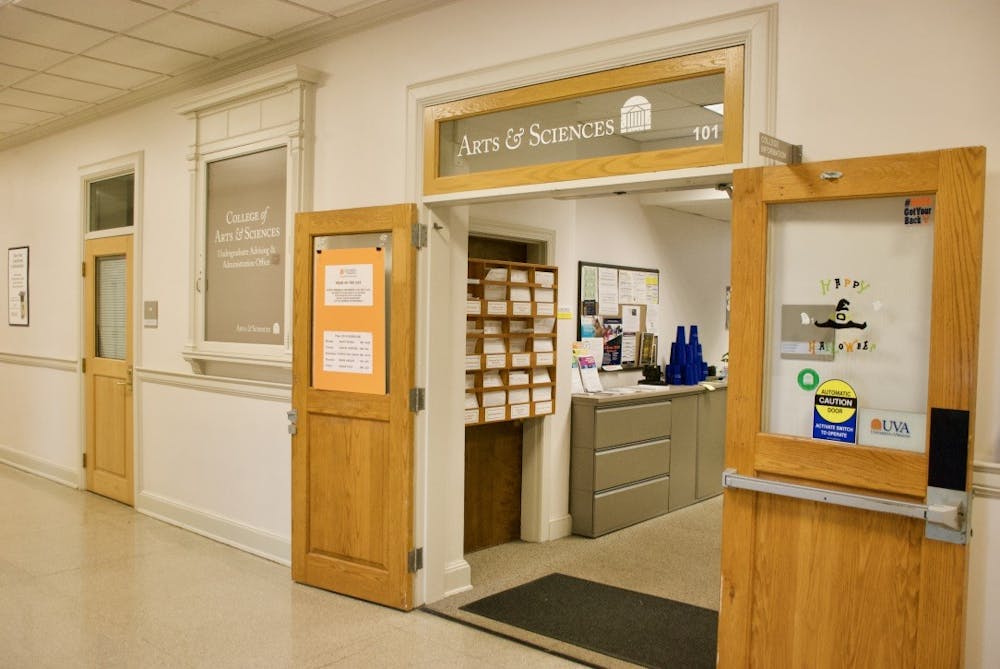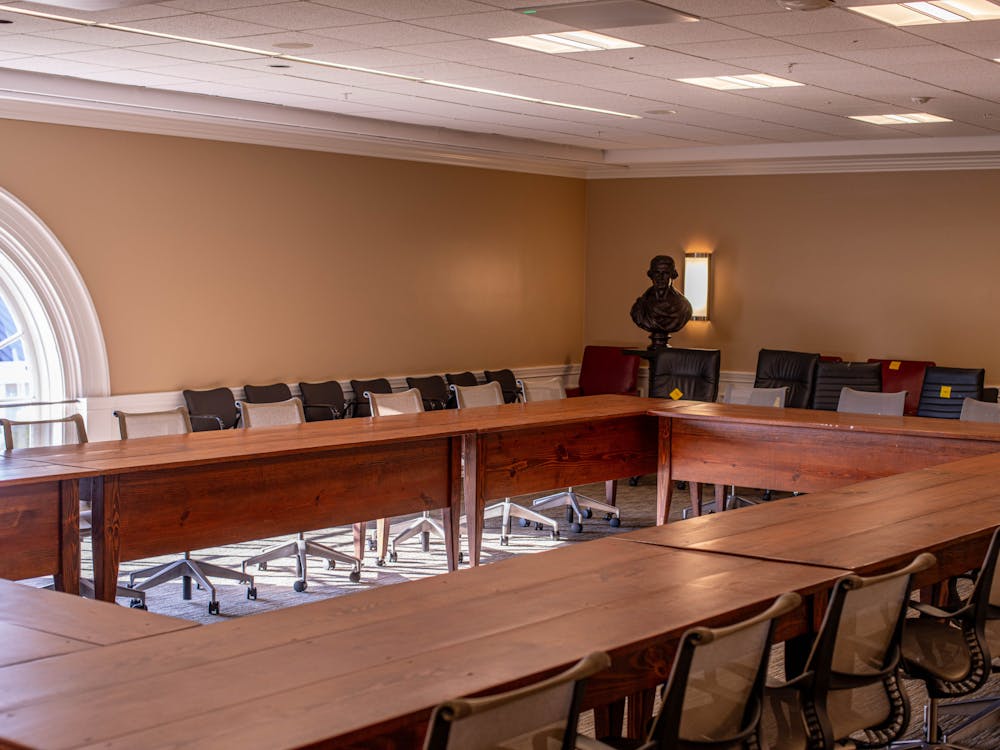As the end of the first semester approaches and students plan schedules for the spring, the University estimates that at least 8,000 advising appointments were made in the weeks leading up to course enrollment for the spring semester. However, some first-year students were notified by their faculty advisors that their holds had been released — eliminating the need for students to meet with them prior to course selection.
“I received an email from my advisor a few days ago that said I did not have to meet with him, as all my holds had been released,” first-year College student Nikita Faria said. “I feel that my faculty advisor has not been helpful thus far in the year but not by any fault of his own. I simply have not asked him for any help.”
Vice Provost Archie Holmes said the University’s faculty-run advising program sets it apart from other institutions by allowing students to turn to professors directly as a resource on-Grounds.
“I feel that advising needs to support students in their educational and personal growth so that they are prepared for the personal and professional lives after their time on Grounds,” Holmes said. “As such, our model has the faculty advisor at the center with resources across Grounds to best support the faculty advisors and their advisees.”
All faculty advisors are required to meet with their advisees at least once during the student’s first-year on grounds, in order to release enrollment holds. The University does not have information on how many faculty advisors waive students’ holds without meeting with them prior to course enrollment.
Faria said she primarily interacts with her advisor through her COLA class.
“I have seen my advisor during my weekly COLA class, yet I have not had any one-on-one interactions with him,” Faria said.
COLA classes are one-credit classes for first-year students whereby 20 percent of the class is devoted to advising and resources, while about 80 percent of the class is concentrated on the unique academic topic of the course. This semester, 707 first-year students are enrolled in COLA courses.
COLA instructors are assigned as faculty advisors for the students enrolled in their course. According to Rachel Most, associate dean for undergraduate academic programs, COLA instructors “are expected to provide accurate and timely information and advice,” like all advisors.
“They take the specific needs or interests of the students in mind,” Most said. “They are expected to refer students out to departments and other offices as needed. U.Va. is large and we want students to get their information from primary sources.”
The University has been discussing ways to improve its advising structure in order to better engage students and ensure more meaningful student-advisor relationships. Challenges regarding the advising structure were last discussed by the Academic and Student Life Committee of the Board of Visitors in June 2019.
During the meeting, the Board addressed the challenges of ensuring a broader range of advising and support programs for minority student populations, including but not limited to first-generation, low-income and transfer students.
The Board also discussed challenges regarding effective communication between students and advisors — proposing increased training opportunities for peer mentors and advisors.
According to a summary from the meeting, the College and Graduate School of Arts and Sciences “has the highest advising load,” with over 11,322 undergraduate advisees during the fall of 2018. Each incoming first-year student is assigned both an association dean as well as a faculty advisor in order to help them navigate the University, discover valuable resources and settle into their new environment on Grounds.
The Board said the purpose of faculty advisors is to promote focused advising, help students select courses for the upcoming term and offer advice on majors. Faculty advisors are encouraged by the University to develop personal relationships with students.
However, some first-year students have noted that since arriving on Grounds, their relationships with assigned faculty advisors have failed to reach a personal or meaningful level.
First-year Nursing student Carina Anderson said she has not yet been able to develop a personal relationship with her advisor, saying they only met once and it was not a one-on-one interaction.
“I’ve seen her around many times because she's a very prominent face in the Nursing school, but I haven’t met with her at a personal level,” Anderson said. “I don’t think she would recognize me if she saw me around Grounds. She may recognize my face, but I don't think she could put a name to my face.”
Advising structures differ for each academic school. However, all schools expect faculty advisors to develop meaningful relationships with their advisees and act as a valuable resource on Grounds.
Ed Murphy, astronomy professor and faculty advisor, touched on the importance of meaningful student-advisor relationships and the benefits of COLA classes. Murphy was the 2017 recipient of the Edward L. Ayers Advising Fellowship, which recognizes faculty who demonstrate dedication to advising students.
“The most important part about advising is getting to know the students,” Murphy said. “The problem I had with the advising system before I started teaching a COLA class was that I wouldn’t get to know the students at all.”
According to Murphy, typical student-advisor meetings would last only 15 to 20 minutes. During these appointments, Murphy said that his advisees would go over schedules with him but failed to open up and discuss personal matters or future plans.
“So, in their whole time that I was their advisor, I would see them three or four times for never more than about 15 minutes,” Murphy said. “For me, personally, I just didn’t think that it was a great way to advise students.”
The University does provide training for faculty advisors and association deans in order to ensure they are able to best support students in both their personal and professional endeavors.
According to Associate Dean Most, faculty advisors receive training from the association deans and other external offices in August, and ongoing trainings are held as needed throughout the year in order to stay current with any changes in College programs.
The University has distinguished its advising and related support services as, potentially, “a key differentiator for the University.”
In its 2013 Cornerstone Plan, the University made “total advising” a priority. Total advising refers to an integrated approach to academic advising that combines career counseling and personal coaching in order to provide students greater access to valuable academic resources and support services.
Since the inception of total advising, the University has continued to institute new initiatives, such as the creation of COLA classes, the Georges Student Center and the expansion of the University Career Center’s services, in order to ensure more advising opportunities for students.
When asked what he felt the weaknesses of the University’s advising structure were, Murphy said a major challenge is creating a close relationship between students and their advisors.
“I think the distance between faculty and students is a big part of it,” Murphy said. “And we're all just busy. Faculty are busy, students are busy. It's hard to find ways to bring those two groups together.”
Murphy added that the University’s model of having members of faculty serve as advisors is a strength of its advising program.
“We do not have a core of academic advisors who do this professionally or do this full time,” Murphy said. “The students actually come visit faculty members who have often been at the institution for a long time and know a lot of things about the institution. I think having faculty members as your advisors is a great strength of our system.”
However, students in the College feel the weaknesses in the advising structure lie in advisors’ inability to tend to their major-specific needs.
“My advisor is not based on my potential major but instead on the COLA that I am taking and, therefore, does not have much insight on my specific questions,” Faria said.
Although students receive a major-specific advisor once they declare, first-year students are generally assigned faculty advisors based on their curriculum, COLA class or area of interest requested on their student information form.
In addition to their primary faculty advisor, Most recommends students develop relationships with professors outside of the ones assigned by the University.
“Faculty-student relationships are critical to the success of the student, but that relationship may or may not be with the primary academic advisor,” Most said. “We encourage students to collect advisors. We want them to meet with their assigned faculty advisor, but since advising comes in many forms, we also tell them to meet their association deans, get to know one faculty member well each semester, or at least each year, talk with graduate students and connect with support services on Grounds.”







